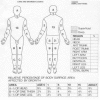Burns
- PMID: 16543335
- PMCID: PMC1403274
- DOI: 10.1136/bmj.332.7542.649
Burns
Erratum in
- BMJ. 2006 Apr 1;332(7544):755
Figures













References
-
- Herndon D. Total burn care. 2nd ed. London: Saunders, 2002.
-
- National Burn Care Review. National burn injury referral guidelines. In: Standards and strategy for burn care. London: NBCR, 2001: 68-9.
-
- Burnsurgery.org (a website designed to be a comprehensive educational tool for burn care professionals worldwide) www.burnsurgery.org
Publication types
MeSH terms
LinkOut - more resources
Full Text Sources
Other Literature Sources
Medical
